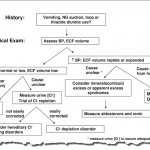Alkalemia
hypokalemia (and sensitization to dig related arrhythmias)
reduction of ionized calcium leading to neurologic symptoms
Stimulates anaerobic metabolism
Metabolic Alkalosis
Plasma bicarb>45
seek to lower it to
- Nasogastric Suction/Vomiting
- Diuretics-from increased loss of urinary electrolytes and water. Cl loss balanced by reabsorbtion of bicarb, H+ moves into cells to allow eflux of K. Mg loss promotes loss of K
- Hyperaldosteronism
- Volume depletion: contraction alkalosis. Stimulation of renin-angiotensin to waste H+
- Organic Ion administration-Lactate, acetate, and citrate. (need 8 units of blood to affect pH.)
- Posthypercapnia-if chronic
Contraction alkalosis because relatively more bicarb in a smaller space (sketchy concept)
Patients need NaCl and Potassium Chloride
Can give hydrochloric acid
need 0.1 to 0.2 N solution (100 to 200 mmol per liter)
0.5 * kg * desired reduction in bicarb=mmol of acid needed
Volume in L of 0.1 M=desired mEQ/100 mEq/L
Using 0.2 desired mEq/200 mEq/L
Infuse at 0.2 mEq/kg/hour
Cl responsive if urine Cl is
Vomiting, gastric drainage, diuretics, lactate, acetate
Cl Resistant if Cl>20 mEq (Mineralcorticoid excess or K depletion)
excess mineralcorticoid (cushings, hyperaldo, ACTH tumors, licorice, renal art stenosis, steroids,)
severe k deficiency
mag deficiency
associated with high mortality (South Med J 1987;80(6):729)
3 Causes from a Renal Perspective
from Joel Topf
- Conditions with chloride depletion with secondary collecting duct hydrogen stimulation
- Conditions with primary stimulation of the collecting duct hydrogen secretion
- Increased Alakli Intake with renal failure
Respiratory alkalosis:
Acute
a.HCO3- drops 1 to 3.5 mEq/L for every 10 mm Hg drop in P CO2 .
Limit of compensation: bicarbonate is rarely below 18 mEq/L.
Chronic (renal compensation starts within 6 hours and is usually at a steady state by 1.5 to 2 days)
a.HCO3- drops 2 to 5 mEq/L for every 10 mm Hg drop in P CO2 .
Limit of compensation: bicarbonate is rarely below 12 to 14 mEq/L.
Pseudorespiratory Alkalosis
severely reduced pulmonary perfusion with normal alveolar ventilation (i.e. you’re bagging a shocked patient)
less CO2 is delivered and more CO2 is extracted (b/c of poor systemic perfusion and poor relative pulmonary perfusion respectively)
So get arterial eucapnia or even hypocapnia with a severely acidotic and hypercapnic venous and tissue state
